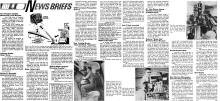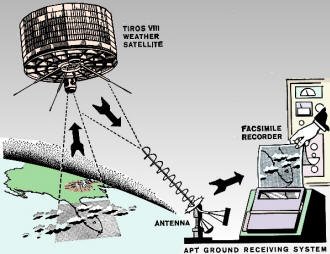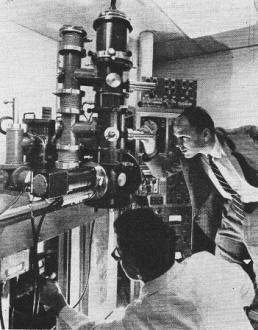|
March 1964 Radio-Electronics
 [Table of Contents] [Table of Contents]
Wax nostalgic about and learn from the history of early electronics.
See articles from Radio-Electronics,
published 1930-1988. All copyrights hereby acknowledged.
|
 At the time of this "News
Briefs" feature in a 1964 Radio-Electronics, satellites were a
relatively new phenomenon. Tiros VIII was already, as the nomenclature implies,
the eighth in the series of ten so-named weather satellites. Tiros, BTW, stands
for
Television Infrared Observation Satellites. Tiros VIII was the first to
broadcast images to widely dispersed ground stations that used them for
preparing local forecasts and reports. It was the beginning of the live
satellite images on TV era. In other news, a new type scanning electron
microscope was revealed by Westinghouse which could produce images only 15
millionths of an inch in less than a second. A gas laser triode was
announced by Bell Telephone Laboratories, whose output could be modulated by a
control grid. This was a first step in laser communications. I colorized the
line
drawing to bring it up to 21st century expectations. At the time of this "News
Briefs" feature in a 1964 Radio-Electronics, satellites were a
relatively new phenomenon. Tiros VIII was already, as the nomenclature implies,
the eighth in the series of ten so-named weather satellites. Tiros, BTW, stands
for
Television Infrared Observation Satellites. Tiros VIII was the first to
broadcast images to widely dispersed ground stations that used them for
preparing local forecasts and reports. It was the beginning of the live
satellite images on TV era. In other news, a new type scanning electron
microscope was revealed by Westinghouse which could produce images only 15
millionths of an inch in less than a second. A gas laser triode was
announced by Bell Telephone Laboratories, whose output could be modulated by a
control grid. This was a first step in laser communications. I colorized the
line
drawing to bring it up to 21st century expectations.
New Briefs:
11/57 |
8/58 |
11/59 |
2/60 |
4/60 |
8/60 |
9/60 |
10/60 |
12/60 |
1/61 |
3/61 |
5/61 |
6/61 |
7/61 |
8/61 |
9/61 |
10/61 |
11/61 |
12/61 |
1/62 |
2/62 |
3/62 |
4/62 |
5/62 |
7/62 |
8/62 |
9/62 |
3/63 |
4/63 |
8/63 |
9/63 |
3/64 |
8/64 |
12/64 |
1/67 |
3/67 |
4/67 |
5/67 |
6/67 |
9/67 |
4/68 |
9/68
News Briefs

How Tiros VIII works. Viewing an area approximately 1,000 miles on a side, it
snaps a picture on a special vidicon tube which retains the image on the screen
for 208 seconds while it is being read out and transmitted to APT facsimile receivers.
The facsimile picture is 8 inches on a side.
New Weather Satellite Broadcasts Local Reports
Tiros VIII, latest of America's weather satellites, carries a special automatic
transmitting system that sends pictures to earth via relatively simple ground stations.
The first seven satellites sent rather complex pictures on command for reception
by special ground stations. Tiros, called "everyman's weather satellite," broadcasts
its signals so that individual localities will be able to obtain direct readout
pictures of what the weather activity over a local region looks like from 400 miles
in space.
The pictures are recorded by facsimile rather than on film. The quality is not
as good as that of film pictures but will provide as much information as local meteorologists
will need. The new system, called APT, for Automatic Picture Transmission, is already
transmitting to more than 50 ground stations throughout the world.
Relay I Won't Quit
NASA's Communications Satellite, Relay I, launched from Cape Canaveral on Dec.
13, 1962 kept working and merrily answering questions from earthmen after Dec. 31,
1963, which was supposed to be its last working day. It was equipped with a self-destructive
timing device to switch off its power about a year after launching. Engineers, believe
that it failed to go off because of the extreme cold.

The first successful scanning electron microscope in the
United States, being use to study surfaces of tine microelectronics devices.
Richard P. Dunphy, RCA project manager for Relay, explained that "the reason
for the planned silencing of the satellite was that the more advanced Relay is scheduled
for launch shortly and, since Relay I will have completed its mission, it was deemed
good sense to silence it so that its signal would not be added to the already limited
radio-frequency spectrum." He said that an electrolytic material was placed inside
Relay which was supposed to eat away a connection between the main power lead and
the solar panels at a pre-determined rate. But unexpected coldness around the device
has slowed down the erosion.
New Electron Microscope Uses Scanning Techniques
Combining the principles of the electron microscope and the TV receiver, a new
instrument, designed by Westinghouse Research Laboratories, displays detailed pictures
of areas only about 15 millionths of a square inch on a 5-inch screen. It also gives
equally detailed pictures of the electric fields of the surface scanned. Thus one
can see the actual voltage distribution across a resistor or transistor in operation.
As in the regular electron microscope, the electrons comprising the beam are
accelerated to high speed by an applied voltage and focused with magnetic coils
on to the sample. Then magnetic coils like those on a TV yoke guide the beam across
and down the surface in the scanning operation.
The electrons striking the surface cause the sample to emit low-voltage secondary
electrons in quantities determined by the surface structure and charge. These electrons
are collected, amplified and fed as an electrical control signal to a special TV
picture tube, where a visible image of the surface is displayed.
The scanning time for a specimen can be varied from 1/4 to 4,000 seconds. The
number of lines can be varied from 250 to 1,000, the 1,000-line setting giving about
four times the picture detail of a regular television picture.
Posted July 10, 2024
|































